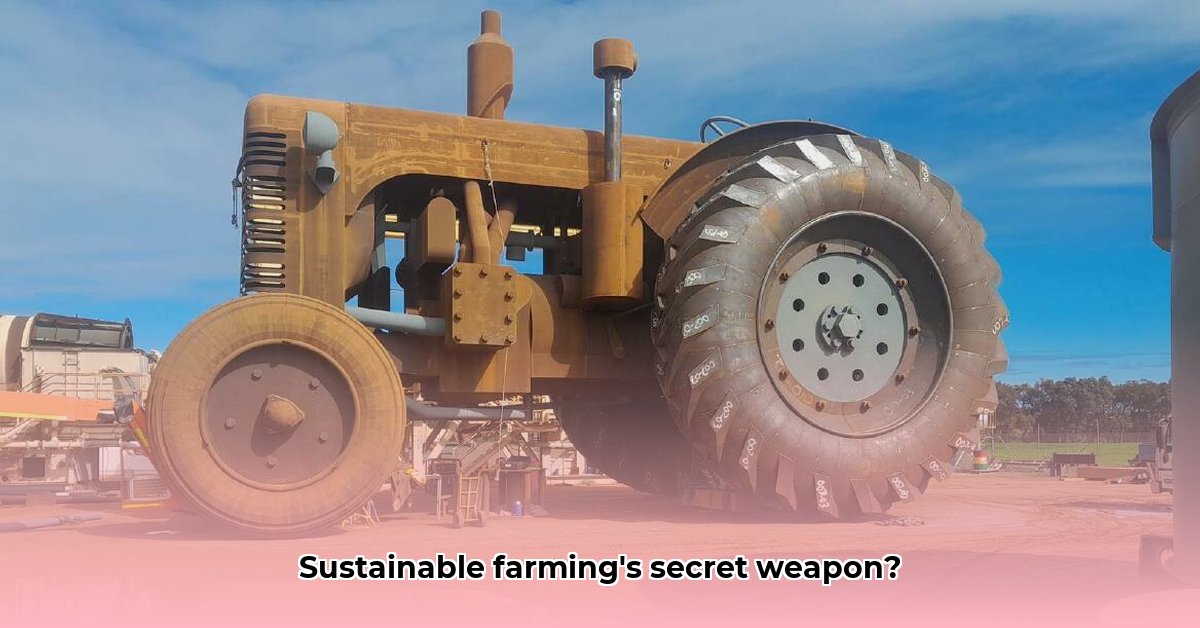
The Rise of Giant Farm Machines and Sustainable Agriculture
Farming is undergoing a transformation. Larger farms are becoming the norm, and labor shortages are a growing concern. Massive tractors are emerging as a key solution, offering both increased efficiency and the potential for sustainable practices. These machines aren't just bigger; they incorporate advanced technologies designed to optimize productivity while minimizing environmental impact. Their ability to cover vast areas quickly translates to significant savings in time and fuel, benefiting both the farmer's bottom line and the planet. However, the question remains: can the benefits outweigh the potential drawbacks? For those considering the investment, understanding the costs is crucial: tractor leasing costs.
Balancing Power and Environmental Responsibility: Soil Health and Beyond
These powerful tractors, while boosting crop yields, present a challenge: soil compaction. Their weight can compress the soil, hindering water infiltration and negatively impacting soil health—a critical element of sustainable agriculture. However, manufacturers are actively developing solutions, including low-ground-pressure tires and technologies designed to minimize soil disturbance.
While initial results are promising, comprehensive long-term data is still needed to fully assess the impact of these massive machines on soil health and overall ecosystem integrity. This requires continued research and monitoring to ensure responsible implementation. How can we ensure that the increased productivity doesn't come at the cost of long-term soil fertility?
Stakeholder Impact: Farmers, Manufacturers, and Governments
The benefits of massive tractors are not evenly distributed. Large-scale farmers are likely to experience immediate increases in productivity, while equipment manufacturers see a surge in demand. However, the high initial investment poses a significant barrier for smaller farmers. Government policies, including subsidies and incentives, are crucial to make this technology accessible to a wider range of farming operations, promoting equitable access and supporting sustainable agricultural practices across the board. How can we bridge the gap between large-scale and small-scale farmers in accessing and benefiting from this technology?
The Future of Mega-Tractors: Innovation and Sustainability
The future of agriculture looks bright, powered by technological advancements in mega-tractor development. Expect to see self-driving capabilities, precision farming tools, and the adoption of alternative fuels – electric and hydrogen-powered tractors promise significant reductions in greenhouse gas emissions. Data-driven farming will further optimize operations, minimizing waste and maximizing resource efficiency.
However, responsible technological development is paramount. Sustainability must be at the forefront of design and implementation. This includes a focus on soil health, water conservation, and emission reduction. Ongoing research and collaboration among stakeholders are vital to ensure that this technology contributes to a more environmentally friendly and resilient agricultural system. What are the most promising technological advancements that can significantly enhance the sustainability of mega-tractor usage?
Comparative Analysis: Key Manufacturers and their Approaches
The market offers several choices, each with its own strengths and weaknesses. While comprehensive comparative data remains limited, some manufacturers stand out:
| Manufacturer | Strengths | Potential Drawbacks |
|---|---|---|
| John Deere | Extensive dealer network, advanced technology | High initial cost, potentially higher maintenance |
| Case IH | Durable construction, diverse model range | Fuel efficiency can vary |
| New Holland | Competitive pricing, reliable performance | May not offer the most advanced features |
| Massive Tractors | Focus on sustainability features, innovative design | Relatively new to the market; more data needed |
The choice of equipment depends heavily on individual farm needs and budget. Remember, sustainability encompasses not just the tractor, but holistic farm management practices.
Reducing Tractor Fuel Consumption: A Multifaceted Strategy
Optimizing fuel efficiency is crucial for both economic and environmental sustainability. Multiple strategies are needed, impacting driving techniques, maintenance, field management, and technology adoption.
1. Efficient Driving Techniques: Gentle acceleration, consistent speeds, and selecting appropriate gears are critical for fuel conservation. This can lead to a 10-15% reduction in fuel consumption. "Efficient driving is not just about saving money; it's a core element of sustainable farming," says Dr. Amelia Hernandez, Agricultural Engineer at Purdue University.
2. Preventative Maintenance: Regular maintenance, including oil changes and filter replacements, significantly impacts fuel economy. Neglected maintenance can decrease efficiency by as much as 20%.
3. Precision Farming Technology: GPS-guided systems reduce fuel waste by minimizing overlap and ensuring precise field operations. "Precision farming is the future of sustainable agriculture," explains Professor David Miller, Professor of Agricultural Economics at the University of California, Davis. "It allows farmers to make better decisions, leading to significant savings in fuel and resources."
4. Strategic Field Management: Careful route planning, minimizing turns and backtracking, and conservation tillage techniques can significantly reduce fuel consumption. These strategies can improve efficiency by 5-10%.
5. Exploring Alternative Fuels: Research into biofuels and other alternative fuels holds the key to further reducing the environmental impact of large tractors.
The path towards sustainable agriculture requires a holistic approach incorporating all these strategies for optimal results. The long-term benefits extend beyond cost savings; they include a healthier environment and a more secure food supply.